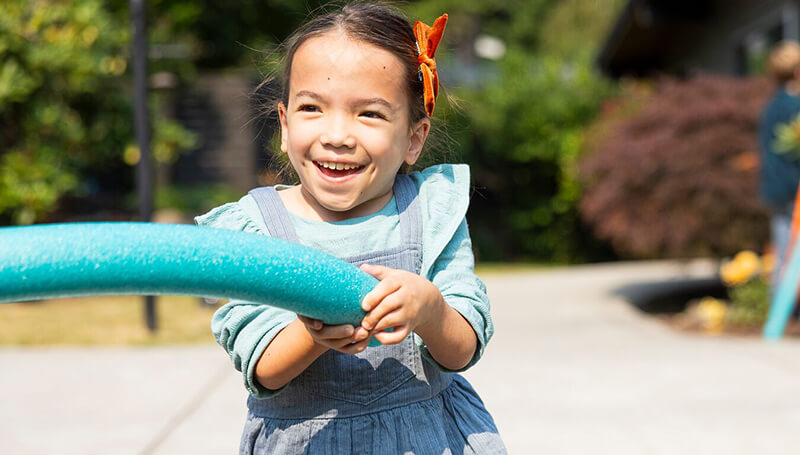Good Growing
Winter 2025
Dealing With Big Feelings in Healthy Ways
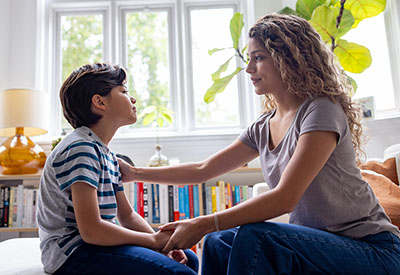 For kids and adults alike, our emotions show how we’re feeling as we respond to experiences. We can express ourselves verbally, with words. At other times, we show our emotions in non-verbal ways — such as blushing, raising our eyebrows or having our eyes fill with tears. And when we express ourselves both verbally and nonverbally, that makes it extra clear how we’re feeling.
For kids and adults alike, our emotions show how we’re feeling as we respond to experiences. We can express ourselves verbally, with words. At other times, we show our emotions in non-verbal ways — such as blushing, raising our eyebrows or having our eyes fill with tears. And when we express ourselves both verbally and nonverbally, that makes it extra clear how we’re feeling.
Dealing with big feelings and expressing emotions in appropriate ways are important life skills. People who have these strong social skills tend to have more self-confidence, better physical health and greater success at school and work. They also have healthier personal relationships, which are essential for a happy life.
It takes practice to develop these skills. The process requires what’s called ‘emotion coaching’ and — you guessed it! — parents make the best coaches. As parents, it’s our job to model healthy ways to express emotions and teach our kids to do so.
Emotion coaching helps a child avoid acting out in negative ways when they are distressed. It gives them better options than behaviors such as screaming, saying hurtful things, slamming doors, breaking things, or striking something or someone. Emotion coaching requires a parent to tune in to their child and be aware of their emotions. This starts with listening carefully and with compassion. Then, we can let them know that we understand and accept their feelings. We can help them name their big emotions using words they can understand — like sad, angry, disappointed and frustrated. And we can help them find better ways to solve a problem or deal with an upsetting situation.
Of course, not every big emotion requires coaching. Expressing intense feelings can be wonderful — like shouting with delight or laughing until we feel weak. And having a good cry when we’re terribly sad can be helpful and healing.
Seattle Children’s offers a free, on-demand Behavior Basics class to help parents develop skills that can improve a variety of behavior challenges. Targeted to parents of kids ages 5 to 12, this virtual course features short videos of experts sharing practical tips to use at home, plus a downloadable workbook.
When a child suddenly expresses big emotions in a negative way, it can be upsetting for everyone. However, when we validate a child’s feelings and help them use their coping skills, it becomes an opportunity for meaningful teaching — and even more closeness!
Eat From the Rainbow
 Does your family eat from the rainbow? If you enjoy a colorful variety of produce, the answer is yes!
Does your family eat from the rainbow? If you enjoy a colorful variety of produce, the answer is yes!
Eating fruits and vegetables in a range of colors ensures you’re getting essential vitamins, minerals and nutrients — which is key to protecting your child’s heart health now and in the future.
While we may associate fresh produce with summer, it’s available all year round. Go for locally grown, in-season produce when you can; farmers’ markets are great for sampling something new. In-season winter produce includes Brussels sprouts, bok choy, kale and cabbage. And grocery stores always offer colorful fall crops like apples, beets, carrots, sweet potatoes and squash — plus citrus fruits grown in warmer climates.
Why not scout the fresh produce with your child, then make something tasty like a broccoli quiche or an apple carrot muffin? If fresh produce isn’t easily available, frozen fruits and veggies are nutritious, convenient and budget-friendly — and ideal for smoothies, soups, stir-fry dishes and baked goods.
Learn more about healthy eating habits.
Serious Warnings for Cough and Cold Medicines
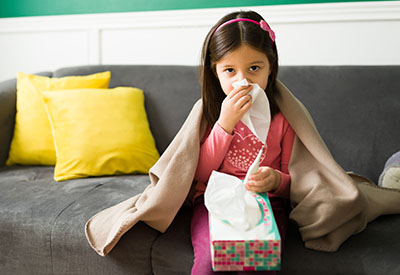 When a child is sick with a cough and/or a cold, it’s natural to want to treat all their symptoms in hopes of making them get well faster. But in fact, treating symptoms doesn’t shorten the illness — and oftentimes, treatment isn’t needed.
When a child is sick with a cough and/or a cold, it’s natural to want to treat all their symptoms in hopes of making them get well faster. But in fact, treating symptoms doesn’t shorten the illness — and oftentimes, treatment isn’t needed.
The American Academy of Pediatrics warns that cough and cold medicines can cause serious harm to young children. Potential side effects include slowed breathing, which can be life-threatening, especially for infants and young children.
- For babies and children under 4, these over-the-counter medicines are not recommended.
- For children ages 4 to 6, use cough and cold medicines only when recommended by your child’s doctor.
- For kids older than 6, these medicines can be used only when you carefully follow the instructions on the package and use the dosing tool that came with the product.
Most sniffles and coughs don’t require a doctor’s visit. And rather than treating symptoms, it’s best to treat a child based on how they’re doing: their energy, appetite and comfort. If you’re not sure, the Seattle Children’s Symptom Checker is a handy resource — bookmark it for when you need it. This easy-to-use guide will help you determine how sick your child is, when to call the doctor, and how to treat your child at home when it’s safe to do so. You know your child best. If your child doesn’t look or seem right, or if you have any questions, talk with their doctor.
Visit the ‘Prevent and Treat Illness’ section of our website to learn more.
Quick Tips for Sleep Hygiene
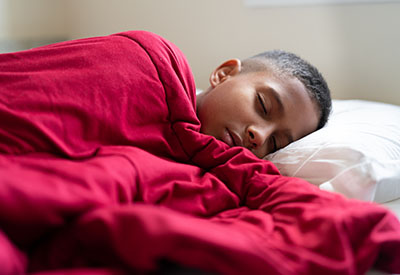 Quality sleep is essential for everyone. It restores us both physically and mentally and is key to our overall wellbeing. Sleep hygiene refers to habits and routines that make it easier to fall asleep and stay asleep.
Quality sleep is essential for everyone. It restores us both physically and mentally and is key to our overall wellbeing. Sleep hygiene refers to habits and routines that make it easier to fall asleep and stay asleep.
Especially during the school year, stick with consistent bedtimes and wake times every day of the week. (Weekend late nights and sleeping in can disrupt healthy sleep patterns for days after.)
Establish a soothing bedtime routine to help your child relax. Turn off all screens and avoid physical exercise and big meals in the hour or so before bedtime. Depending on your child’s age, a cozy nightly routine might include bathing, reading a story or getting a back scratch.
Be sure your child has clean, comfortable sleepwear and bedding, and that their room is dark, quiet and screen-free.
Quality sleep is an investment in our health and happiness — and it’s always worth the effort!
Visit Sleep Hygiene for Children or Sleep Tips for Teenagers to learn more.
Sledding Safety
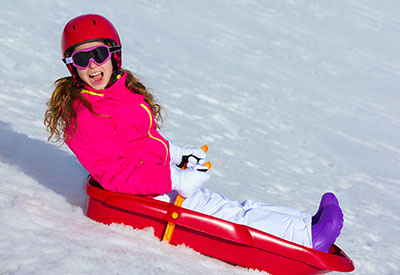 Snow sledding is fun for the whole family, as long as it’s done safely! Ski areas offer the best sledding thanks to long, thrilling runs that are well maintained and free of obstacles. For neighborhood sledding, be sure there are no collision hazards like trees, poles, fences and parked cars. And of course, a sledding path must never intersect a street with car traffic.
Snow sledding is fun for the whole family, as long as it’s done safely! Ski areas offer the best sledding thanks to long, thrilling runs that are well maintained and free of obstacles. For neighborhood sledding, be sure there are no collision hazards like trees, poles, fences and parked cars. And of course, a sledding path must never intersect a street with car traffic.
Helmets are a must: a winter-sport helmet is best, but a bike helmet is better than nothing. And always sled feet first, never headfirst. Be sure everyone has clothing and gear that keep them warm, dry and comfortable. Sledding is an all-ages sport, so be sure you’re there to supervise and take some runs yourself!
Get more winter safety tips.
Get Your Child Back in the Game With Specialized Injury Care
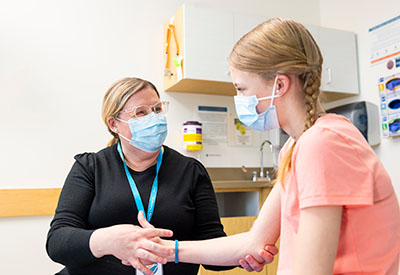 Growing bodies need specialty orthopedic and sports-injury care to get them back to the activities they love, as safely and quickly as possible. Seattle Children’s specializes in treatments that are proven to have the best results for children whose bones are still growing.
Growing bodies need specialty orthopedic and sports-injury care to get them back to the activities they love, as safely and quickly as possible. Seattle Children’s specializes in treatments that are proven to have the best results for children whose bones are still growing.
Because kids keep growing well into their teens, they often need different treatment than adults do — especially relating to their growth plates. Children and young teens have these patches of growing tissue near the end of the long bones. Growth plates determine how long a child’s bones will be once their bodies mature; damage to these areas can affect their growth permanently.
Another reason to see a pediatric specialist is because children’s bone fractures heal differently than adults’ fractures do. For example, sometimes a child’s crooked fracture will straighten out as they grow. This means that a child might need only a cast, whereas an adult with a similar injury might need surgery.
If a child needs imaging that uses radiation, Seattle Children’s has the most board-certified pediatric radiologists in the Northwest. And our hospital and clinics use the least possible amount of radiation to get the best images, thanks to low-dose-radiation X-ray machines.
All care teams at Seattle Children’s have special training in the physical, emotional and social needs of young people. Along with treating the immediate concern, these caregivers consider all the possible long-term results for children as they grow into adulthood. And even young adults who are done growing benefit from seeing pediatric experts who are tuned in to their overall development.
It’s reassuring to know that we see over 40,000 patients each year for orthopedics care — more than any other pediatric hospital in the Pacific Northwest. And we’ve performed more than 10,000 orthopedic surgeries and procedures in the last 5 years; that’s more than any other hospital in the region.
Learn more about Seattle Children’s Orthopedics and Sports Medicine.

